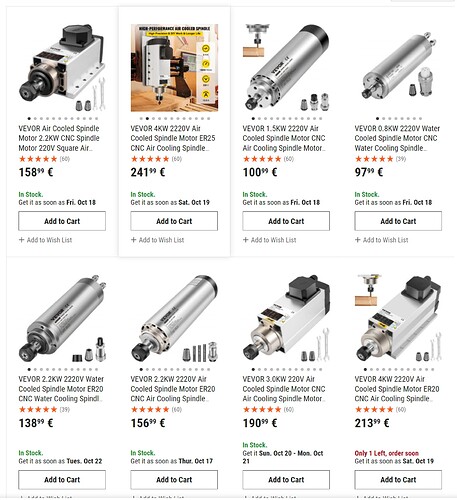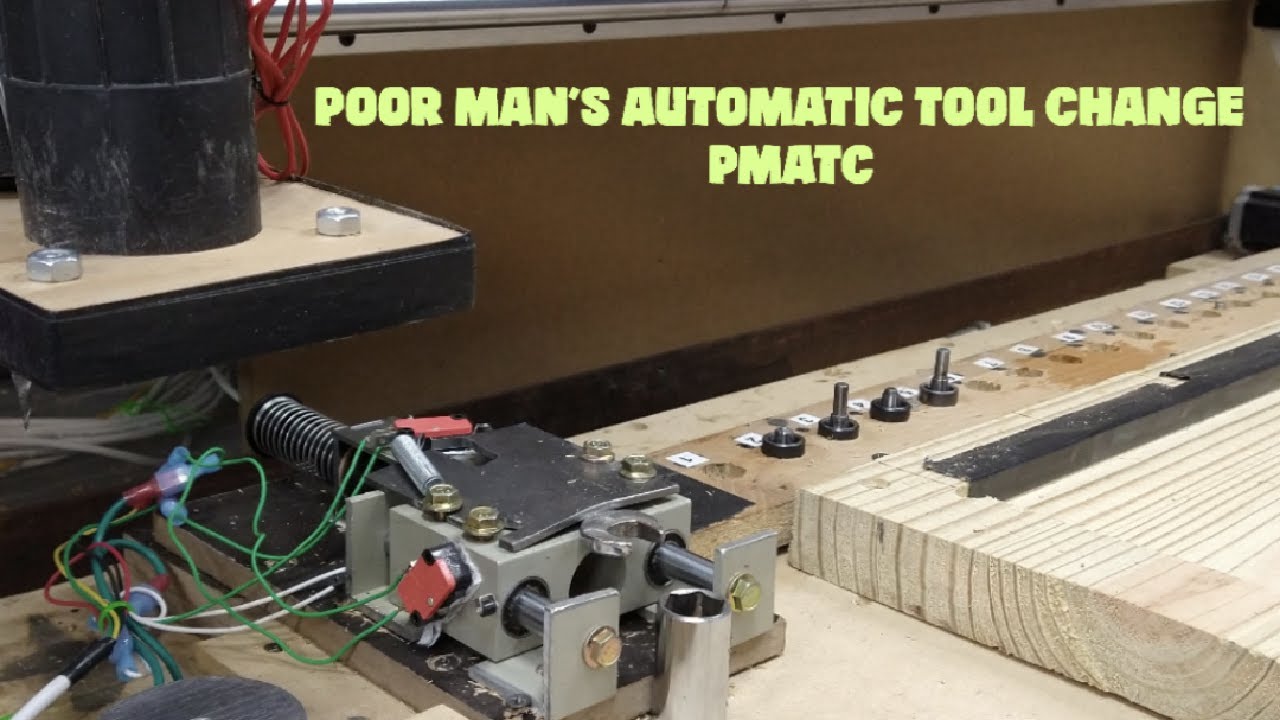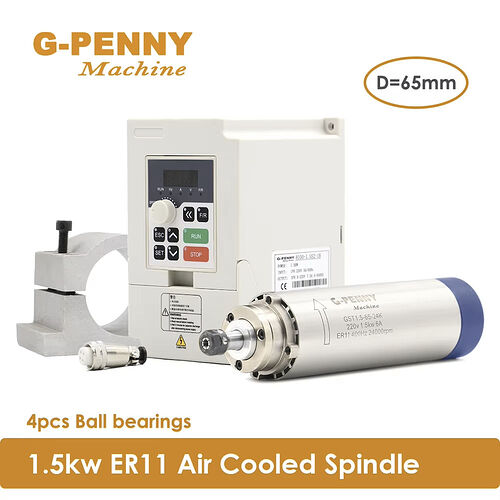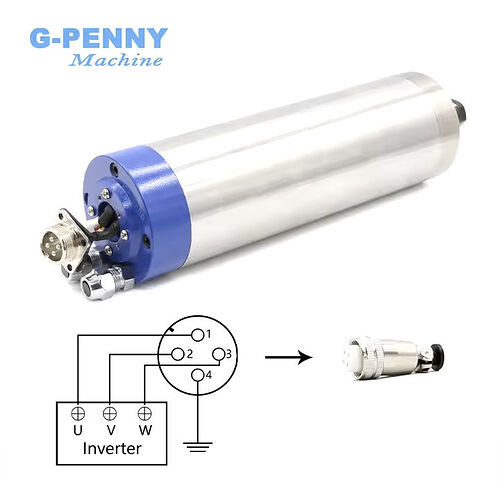Thank you for info about your setup @Dandys_Farm. Am also curious to hear how many folks are running 80mm spindles on their LR3, and what 80mm spindles they’re using, or were hoping to use on their LR4?
The tool mounts are set up a little different on the LR4 than the LR3. And it was done to purposefully move the router/spindle back as close to the rail as it can get. Which made the LR4 MUCH more rigid than the LR3.
In terms of your spindle you arent going to find a water cooled or a 2.2kw in less that 80mm I dont think. Ive been wrong before, but I have never seen one.
There are several options out there for a 1.5kw spindle that is air cooled and 65mm. I run a Vevor one, but sadly it is no longer available. But a quick search on ebay/amazon/aliexpress you will see several that are of the correct size. I have never had a single issue with the power output on the 1.5kw. I run a 1 1/4" surfacing bit on mine with zero issues. And its just as easy to tram as a trim router is.
I am sure you could remix the mount and make the 80mm spindle work. But I am not sure that you will be happy with the performance over a 1.5kw 65mm spindle in the standard location.
Brexit? ![]()
So, for rigidity in the LR4 design, the ideal diameter for a spindle would be around 65mm. Very few of the more powerful 2.2KW spindles are made in that smaller diameter. 80 mm seems more common. This seems to also be the case with the 1.5KW spindles too, many more 80 mm than 65 mm.
Regarding the whole question of spindle versus trim router, I found this Reddit reply very interesting. See below. It was in reply to a question posted under this topic: The beefier end of DC spindles vs reputable trim router.
•3mo ago•
Most of the DC spindles have poor bearings that suffer from play. If the collet holder is a screw on type, the spindle could have a large runout. In general, they don’t have a lot of torque and are pretty loud.
The 800W AC spindles have better bearings and the collet holder is integrated. They run however at 24000 RPM and don’t have much torque at lower RPM. To prevent blunting your end mills fast, you need a minimum chip load of 0.02 mm/tooth/rev. For a 1 flute end mill the minimum feed rate for 0.02 mm/rev is 480 mm/min. That is pretty fast for a non rigid router.
A trim router with adjustable RPM will be the better option for a non rigid router.
I use a (self made) 175W bldc spindle at 3000 RPM. It has the same torque as a 1500W 24000 RPM AC spindle that runs at his max RPM. Because it is a low pole count spindle, it will deliver the same torque at 400 RPM. For non rigid routers, lower RPM spindles are a better option.
Just for learning and fun, the standard DC spindle isn’t a bad way to start.
Checkout this video on what to expect from the lower end routers.
The main thing I’d gain from a spindle is the ability to reverse it. That would be the key (as far as I can tell) to a toolchanger. There are a couple of different designs based on sockets, or gator grip sockets.
Here’s the thing. The second 3D printer I built was a toolchanger. I ended up switching it out for IDEX for a few reasons, but foremost is that I really only used 2 tools (support and print, or 2 colors) for the stuff I do.
I think it would be cool to look at an IDX design, but because of the way tool changes are handled in CNC versus printing (every freakin’ layer) I’m actually thinking I want to play with one of the DIY toolchanger designs.
I could see keeping a chamfering bit ready, which would encourage me to give my parts a professional look.
Just need to find an acceptable spindle that won’t break the bank.
Ok, you lost me here…
Why would you need to run the spindle in reverse to change tools. For that matter, why would you even consider trying to change tools when the router/spindle is powered up? From a safety perspective, I would think that at the very least you would turn off the power before attempting a tool change, if not going the extra step and unplugging it.
But then again, I have one family member who was missing a finger on one hand, and another who is missing two toes on one foot, both from getting too close to rotating machinery, so maybe I’m a bit more cautious than most…
For an ATC (Auto tool changer) like the Rapid Change ATC https://rapidchangeatc.com, you need a spindle that can reverse.
He is talking about an automatic tool changer, not changing the tools by hand. There is a DIY version that you can build. I cant think of the name of it right now or I would look it up and post a link
Chuckle: Automatic is doing some heavy lifting for the tool changers.
Admittedly, some are pretty jank. But some seem to have promise.
Well I learned something new today! Thanks for the links and the education, Looks pretty interesting!
All this talk of spindles got me intrigued, and I found a kit on Aliexpress that seemed decent and was decently priced. It’s 65mm diameter, air cooled, 1.5KW, and comes with a matching VFD. So I’m going to give it a try. With shipping and tax I got it for around $221.
Looks good. Note that link is for 220V.
There is a 110V option, but the specs for that one still show 220V only. Also it says to leave a note on the order for 110V model, so just selecting the 110V option on the order page may or may not get you the right version.
@DougJoseph - Which version did you get?
I ordered the 110v. Since it costs a bit more, I’m wondering if the only difference is the VFD containing step-up transformer function to get 220 from 110.
I did not see that, but maybe the note predates them having a defined way to order a 110 versus a 220. ?
Hope it works out for you. It looks like a very interesting piece of equipment.
The fine print on the web page (in the “view more” section) notes that the air cooled version is “very loud”, which it would be, relative to a water cooled version. I’m wondering if it is any better or worse than a router.
Once it arrives and is in use, can you let us know if it is any different noise level than a palm router (no load/no cutting)?
Looking forward to your review.
Will do.
That spindle looks identical to my Vevor spindle. Wouldn’t surprise me if its made in the same factory and just a different label slapped on it. I wish you great success with it! They do tend to get warm so I would suggest something other than PLA for your tool mount. The Makita mount works great for it, but the Makita dust shoe doesn’t, I ended up running the dewalt dust shoe and that has worked great as well.
@Jonathjon Cool! Thanks for the tips! I had already printed out tool mounts in PETG. And I had not printed out a dust shoe for the full size LR4 yet so that means I can adjust without a waste of printing time there.
Glad I saw it in time. That snout on the Makita/Kobalt one gets in the way for sure. But with the Dewalt one I had plenty of room to get my wrenches in and change bits no problem
I thought about doing a video that’s a comparison of two spindles that are the same with the difference being water cooled versus air cooled, and I will end up with a big LR4 and a small LR4 so I pulled the trigger on a water cooled version of it. Hard to source, but I located it (at a decent price) on the Alibaba site.




